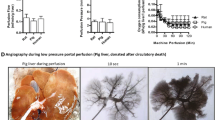Abstract
The use of grafts donated after cardiac death (DCD) would greatly contribute to the expansion of the donor organ pool. Machine perfusion (MP) is a promising technology to improve DCD liver grafts. Several perfusion technologies under various temperature and oxygenation conditions have been suggested and are still debated. It is important to confirm the relationship between oxygen consumption and organ conditions during MP. In this study, we analyzed oxygen consumption during oxygenated MP of porcine DCD liver grafts under different temperature conditions: hypothermic and subnormothermic. Grafts exposed to 60 min of warm ischemia were perfused for 4 h with a modified UW-gluconate perfusate under hypothermic (HMP) and subnormothermic conditions. Oxygen consumption, pressures of the portal vein and hepatic artery, and effluent enzymes were analyzed. Oxygen consumption was strongly related to the graft temperature during MP. Effluent enzyme level of the LDH were lower in the high oxygen consumption group than in the low oxygen consumption group during MP. In summary, we found that high oxygen consumption under subnormothermic temperature conditions has several advantages over HMP for DCD liver graft preservation.






Similar content being viewed by others
References
Le Dinh H, de Roover A, Kaba A, et al. Donation after cardio-circulatory death liver transplantation. World J Gastroenterol. 2012;18:4491.
Cursio R, Gugenheim J. Ischemia-reperfusion injury and ischemic-type biliary lesions following liver transplantation. J Transpl. 2012; 2012: 164329.
Seehofer D, Eurich D, Veltzke-Schlieker W, Neuhaus P. Biliary complications after liver transplantation: old problems and new challenges. Am J Transpl. 2013;13:253.
Heidenhain C, Pratschke J, Puhl G, et al. Incidence of and risk factors for ischemic-type biliary lesions following orthotopic liver transplantation. Transpl Int. 2010;23:14
Guarrera JV, Henry SD, Samstein B, et al. Hypothermic machine preservation in human liver transplantation: the first clinical series. Am J Transpl. 2010;10:372.
Dutkowski P, Graf R, Clavien PA. Rescue of the cold preserved rat liver by hypothermic oxygenated machine perfusion. Am J Transpl. 2006;6:903.
Changani KK, Fuller BJ, Bryant DJ, et al. Non-invasive assessment of ATP regeneration potential of the preserved donor liver. A 31P MRS study in pig liver. J Hepatol. 1997;26:336.
Dutkowski P, Schlegel A, de Oliveira M, Müllhaupt B, Neff F, Clavien P-A. HOPE for human liver grafts obtained from donors after cardiac death. J Hepatol. 2014;60:765.
Fondevila C, Hessheimer AJ, Maathuis MH, et al. Superior preservation of DCD livers with continuous normothermic perfusion. Ann Surg. 2011;254:1000.
Op den Dries S, Karimian N, Sutton ME, et al. Ex vivo normothermic machine perfusion and viability testing of discarded human donor livers. Am J Transpl. 2013;13:1327.
Ravikumar R, Jassem W, Mergental H, et al. Liver transplantation after ex vivo normothermic machine preservation: a phase 1 (first-in-man) clinical trial. Am J Transpl. 2016;16:1779.
Olschewski P, Gass P, Ariyakhagorn V, et al. The influence of storage temperature during machine perfusion on preservation quality of marginal donor livers. Cryobiology. 2010;60:337.
Bruinsma BG, Yeh H, Ozer S, et al. Subnormothermic machine perfusion for ex vivo preservation and recovery of the human liver for transplantation. Am J Transpl. 2014;14:1400.
Obara H, Matsuno N, Shigeta T, Enosawa S, Hirano T, Mizunuma H. Rewarming machine perfusion system for liver transplantation. J Med Device. 2013;7:41011.
Compagnon P, Levesque E, Hentati H, et al. An oxygenated and transportable machine perfusion system fully rescues liver grafts exposed to lethal ischemic damage in a pig model of DCD liver transplantation. Transplantation. 2017;101:e205–13.
Schlegel A, Dutkowski P. Role of hypothermic machine perfusion in liver transplantation. Transpl Int. 2014; 28:1–13.
Schlegel A, De Rougemont O, Graf R, Clavien P-A, Dutkowski P. Protective mechanisms of end-ischemic cold machine perfusion in DCD liver grafts. J Hepatol. 2013;58:278–86. https://doi.org/10.1016/j.jhep.2012.10.004.
Lüer B, Koetting M, Efferz P, Minor T. Role of oxygen during hypothermic machine perfusion preservation of the liver. Transpl Int. 2010;23:944–50.
Koetting M, Lüer B, Efferz P, Paul A, Minor T. Optimal time for hypothermic reconditioning of liver grafts by venous systemic oxygen persufflation in a large animal model. Transplantation. 2011;91:42–7.
Li X, Elwell MR, Ryan AM, Ochoa R. Morphogenesis of postmortem hepatocyte vacuolation and liver weight increases in Sprague–Dawley rats. Toxicol Pathol. 2003;31:682.
Monbaliu D, Libbrecht L, De Vos R, et al. The extent of vacuolation in non-heart-beating porcine donor liver grafts prior to transplantation predicts their viability. Liver Transpl. 2008;14:1256.
Stegemann J, Minor T. Energy charge restoration, mitochondrial protection and reversal of preservation induced liver injury by hypothermic oxygenation prior to reperfusion. Cryobiology. 2009;58:331.
Tolboom H, Izamis ML, Sharma N, et al. Subnormothermic machine perfusion at both 20 °C and 30 °C recovers ischemic rat livers for successful transplantation. J Surg Res. 2012;175:149.
Furukori M, Matsuno N, Meng LT, et al. Subnormothermic machine perfusion preservation with rewarming for donation after cardiac death liver grafts in pigs. Transpl Proc. 2016;48:1239.
Bochimoto H, Matsuno N, Ishihara Y, Shonaka T, Koga D. The ultrastructural characteristics of porcine hepatocytes donated after cardiac death and preserved with warm machine perfusion preservation. PLoS One. 2017;12:e0186352.
Acknowledgements
This work was supported by JSPS KAKENHI (#15H03922 to H. Obara and N. Matsuno) from the Japan Society for the Promotion of Science (JSPS), the Ring Ring Project (26–105 to H. Obara) of the JKA Foundation, and a Grant-in-Aid for Innovative Research in Life Science from Asahikawa Medical University to N. Matsuno.
Author information
Authors and Affiliations
Corresponding author
Rights and permissions
About this article
Cite this article
Morito, N., Obara, H., Matsuno, N. et al. Oxygen consumption during hypothermic and subnormothermic machine perfusions of porcine liver grafts after cardiac death. J Artif Organs 21, 450–457 (2018). https://doi.org/10.1007/s10047-018-1063-0
Received:
Accepted:
Published:
Issue Date:
DOI: https://doi.org/10.1007/s10047-018-1063-0




